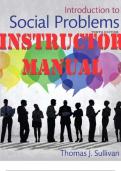, Chapter 1
Approaches to the Study of Social Problems
Chapter Outline
What is a Social Problem?
Personal Troubles, Public Issues, and Social Problems
The Social Context of Social Problems
The Sociological Imagination
Theoretical Perspectives on Social Problems
The Functionalist Perspective
The Conflict Perspective
The Interactionist Perspective
Using the Theoretical Perspectives
Constructing Social Problems: The Mass Media and Other Influences
Research on Social Problems
The Scientific Method
Conducting Research
Applied Research: Untangling Myths and Facts about Social Problems
Values, Interest Groups, and Objectivity
Assessing Data: Problems and Pitfalls
Sampling Problems
Assessing Causality
Measuring Social Problems
Assessing Claims
Applied Research: Untangling Myths and Facts about Social Problems
Future Prospects: Solving Social Problems
What Can We Do About Social Problems?
The Interplay of Social Policy and Research
Who Provides Solutions?
Policy Issues: Domestic Violence: How to Intervene?
Should We Solve the Problem?
International Perspectives: Social Problems in Other Societies
Chapter 1 At-A-Glance
Detailed Instructor Print Media Professor
1
,Instructor’s Manual for Sullivan, Introduction to Social Problems, 10/e
Outline Resources Supplements Supplements Notes
What is a Learning Obj.: Test Bank for PPT for
Social 1 Chapter 1 Chapter 1
Problem? Teach. Sugg.:
6, 7, 9
Theoretical Learning Obj.: Test Bank for PPT for
Perspectives 2 Chapter 1 Chapter 1
on Social Teach. Sugg.:
Problems 2, 4, 12
Research on Learning Obj.: Test Bank for PPT for
Social 3 Chapter 1 Chapter 1
Problems Teach. Sugg.:
1, 3
Future Learning Obj.: Test Bank for PPT for
Prospects: 4 Chapter 1 Chapter 1
Solving Social Teach. Sugg.:
Problems 4, 5, 8, 9, 10,
11, 13, 14
Changes in the Tenth Edition
1. The introduction to the interventionist and laissez-faire approaches to attacking
problems has been expanded by discussion of the Occupy Wall Street and Tea
Party movements as examples of each position, respectively.
Learning Objectives
1. Define when a condition is and is not a social problem, identify the social context
of social problems, and explain what the sociological imagination is.
2. Define the three theoretical perspectives on social problems, compare them with
one another, and explain how social problems are socially constructed.
3. Describe how the scientific method and research are used to understand social
problems, elaborate on the different types of research that are used, and
characterize the problems and pitfalls of scientific research.
4. Identify the things that sociologists do to address social problems, discuss the
role of social policy in this process, compare and contrast the interventionist and
laissez faire approaches to this process, and analyze why this process benefits
by focusing on social problems in other societies and cultures.
2
, Chapter 1: Approaches to the Study of Social Problems
Suggestions for Teaching and Discussion
1. The “Myths and Facts” inserts that open each chapter highlight the distinction
between sociological knowledge and common sense. A number of articles
published in Teaching Sociology focus on the relationship between sociology and
common sense and the implications of this linkage for the classroom. Instructors
may find these articles useful for their own consideration of the
sociology/common sense distinction: James A. Mathisen, “A Further Look at
‘Common Sense’ in Introductory Sociology,” Teaching Sociology, 17, (July, 1989:
307–315); William F. Bengston and John W. Hazzard, “The Assimilation of
Sociology into Common Sense: Some Implications for Teaching,” Teaching
Sociology, 18, (January, 1990: 39–45). Instructors might also want to emphasize
the uniqueness of the sociological method, especially as it compares with
tradition, experience, and common sense as sources of knowledge about social
problems and their solutions. These issues are well developed in Chapter 2 of
Duane R. Monette, Thomas J. Sullivan, and Cornell R. DeJong, Applied Social
Research: A Tool for the Human Services, 8th ed. (Belmont, CA: Brooks/Cole—
Cengage Learning, 2011).
2. Consistent with one of the themes in this text, it can be useful to stress teaching
and learning through the use and analysis of various aspects of media and
popular culture. One approach to this is to use contemporary music as a vehicle
for teaching sociological content. Jarl Ahlkvist describes one approach to this by
teaching students sociological analysis through the study of heavy metal music:
“Music and Cultural Analysis in the Classroom: Introducing Sociology through
Heavy Metal,” Teaching Sociology, 27 (April 1999: 126–144). For material on the
sociological significance of popular music, Andy Bennett has published two
interesting articles based on his research among youth in England and Germany:
“Rappin’ on the Tyne: White Hip Hop Culture in Northeast England: An
Ethnographic Study,” The Sociological Review, (1999: 1-24), and “Hip Hop am
Main: The Localization of Rap Music and Hip Hop Culture,” Media, Culture &
Society, 21 (1999: 77–91). Benjamin D. Albers and Rebecca Bach provide a
rationale and a method for using popular music and popular culture to introduce
specific sociological concepts to students in their article: “Rockin’ Soc: Using
Popular Music to Introduce Sociological Concepts,” Teaching Sociology, 31 (April
2003: 237–245). Students tend to pay more attention to sociological issues when
they see it applied to aspects of their own lived experience.
3. The Applied Research inserts throughout the text emphasize how sociological
information is a valuable source of knowledge for practical applications in solving
social problems. In the past, most introductory sociology and social problems
courses were taught using “academic sociology”. Today, more emphasis is
placed on the applied dimension in sociology, and many departments across the
3






